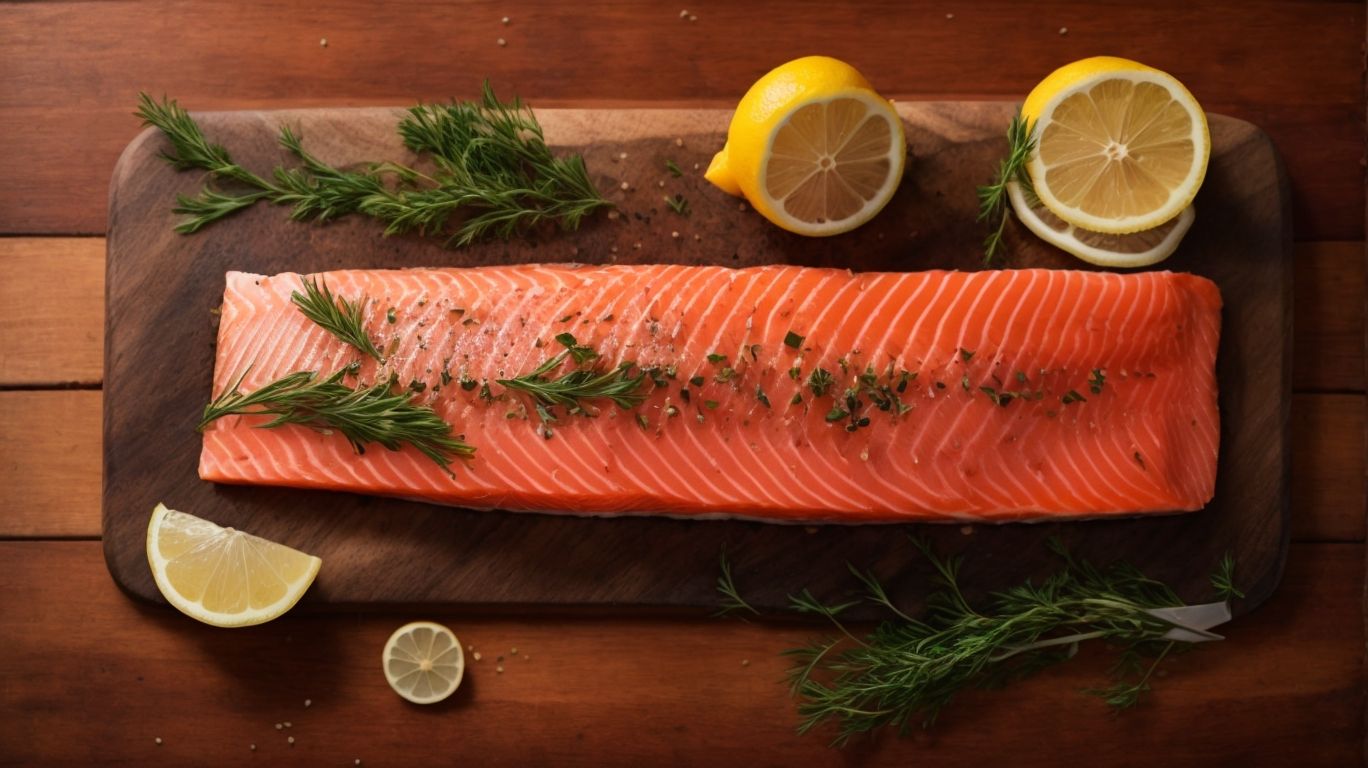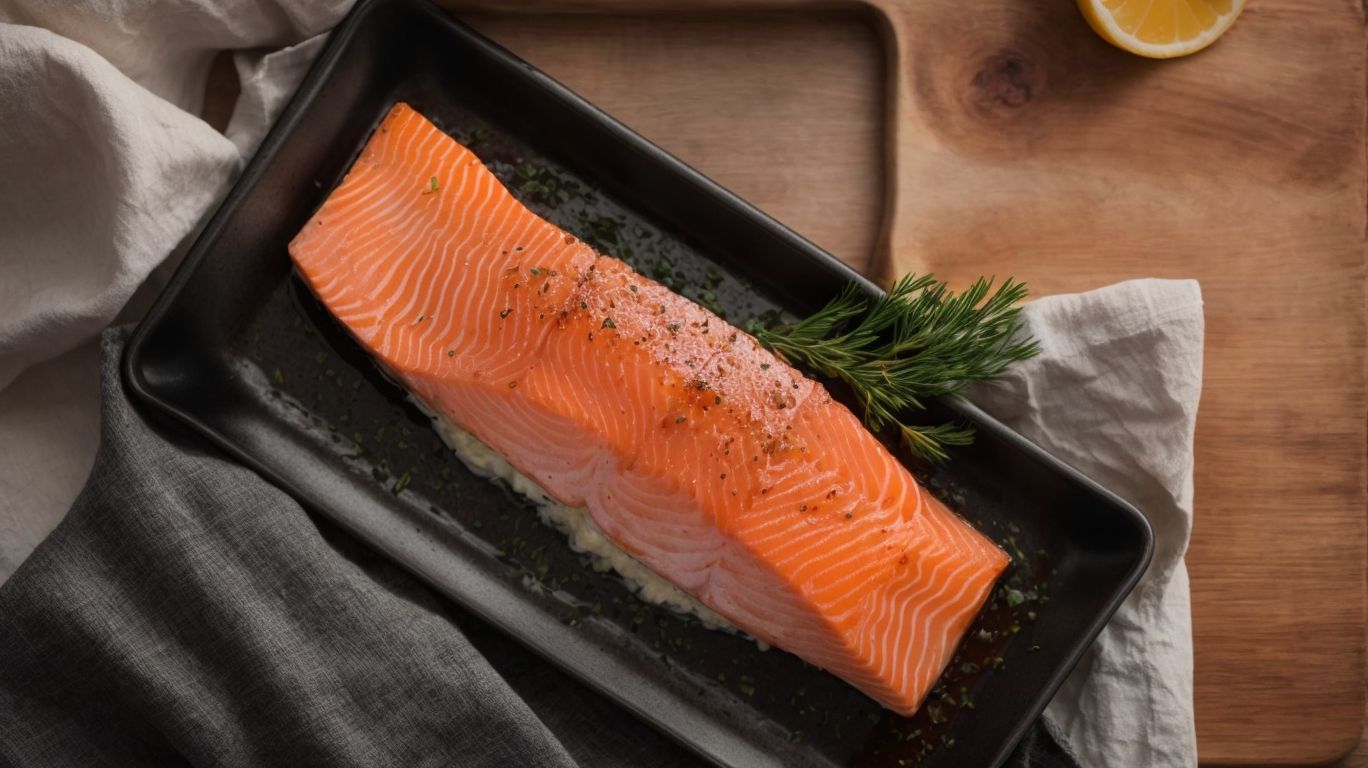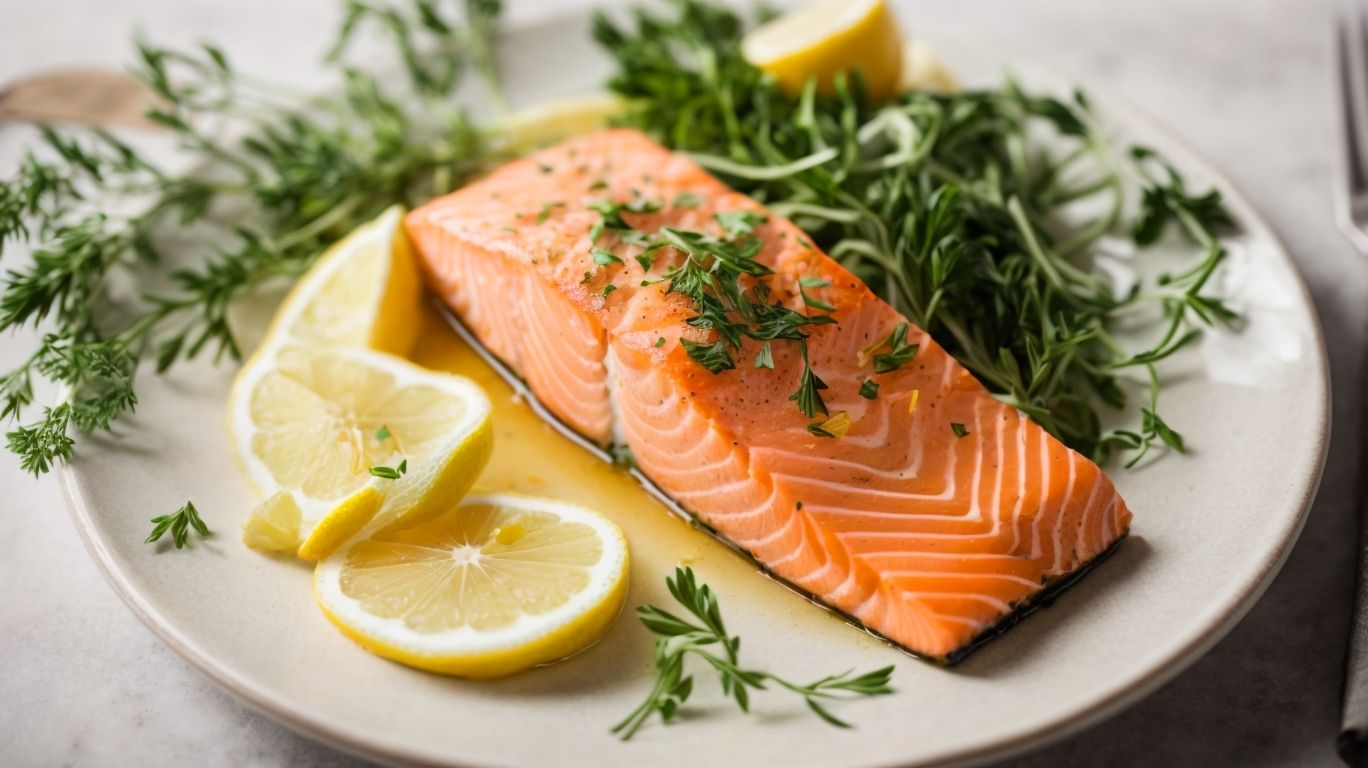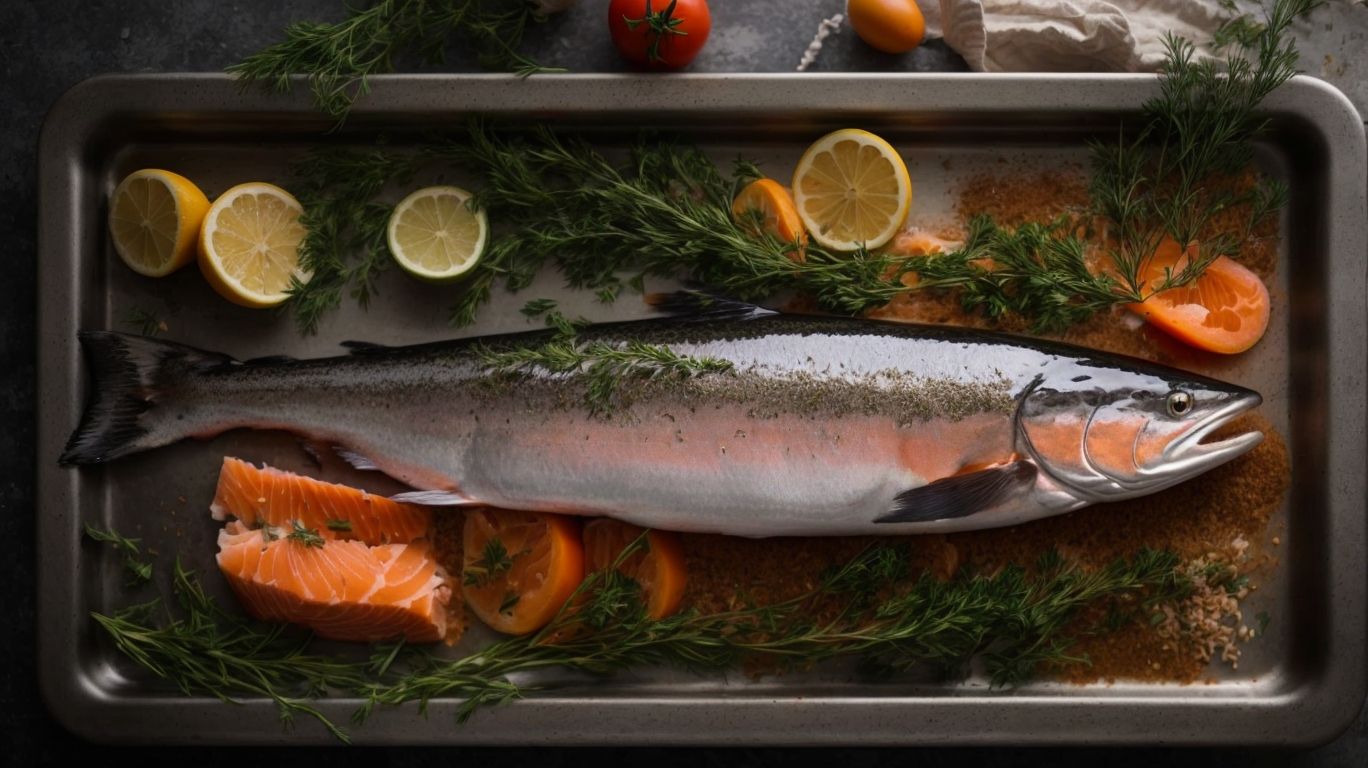How to Bake King Salmon?
Welcome to the ultimate guide on baking king salmon! In this article, we will explore what king salmon is, the various types of salmon available, and why baking king salmon is a delicious and healthy option. We will also discuss the health benefits of king salmon, how to choose the right one, and how to prepare it for baking. From defrosting to seasoning, baking, serving, and storing leftovers, we have you covered. So, grab your apron and let’s get cooking!
Key Takeaways:
What is King Salmon?
King Salmon, also known as Chinook Salmon, is a premium species of salmon highly sought after for its rich flavor and succulent texture. This type of salmon is renowned for its large size and high oil content, making it a favorite among seafood enthusiasts.
When cooked, King Salmon has a buttery and melt-in-your-mouth texture that pairs beautifully with a range of seasonings and cooking methods. Its flavor is often described as rich, buttery, and slightly sweet, with a hint of nuttiness. The flesh of the King Salmon is firm and succulent, with large, moist flakes that make it a versatile ingredient for various dishes.
Due to its high oil content, King Salmon is perfect for grilling, baking, or pan-searing as it remains moist and flavorful even when cooked at high temperatures. The size of King Salmon can vary, with some specimens reaching up to 100 pounds, although more commonly they range between 20-50 pounds, offering ample servings for a delicious meal.
What are the Different Types of Salmon?
Salmon varieties include King Salmon, Sockeye Salmon, Coho Salmon, and Atlantic Salmon. The Pacific and Alaskan regions are known for their abundant wild-caught salmon populations, each offering unique flavors and culinary experiences.
King Salmon, also known as Chinook Salmon, is the largest and often prized for its high fat content and rich, buttery texture. Sockeye Salmon, on the other hand, is recognized for its deep red flesh and robust flavor. Coho Salmon, commonly referred to as Silver Salmon, boasts a milder taste and a firmer texture compared to other varieties. Atlantic Salmon, typically farmed, has a more delicate flavor profile.
In the Pacific Northwest, King and Coho Salmon dominate the fishing scene, known for their excellent quality and taste. Alaskan salmon varieties such as Sockeye and Chum Salmon are celebrated for their exceptional color and distinctive flavors, making them popular choices among seafood enthusiasts.
Why Bake King Salmon?
Baking King Salmon is a popular cooking method that helps preserve the fish’s natural flavors and moisture while allowing for easy seasoning and customization. The gentle heat of the oven ensures a tender and flaky texture, perfect for showcasing the delicate taste of King Salmon.
Baking King Salmon is a healthier alternative to frying or sautéing, as it requires minimal oil and helps retain the fish’s nutritional value. The slow cooking process allows the flavors to develop gradually, resulting in a more complex and rich taste profile. Baking enables you to infuse the salmon with a variety of herbs, spices, and citrus for a personalized culinary experience.
What are the Health Benefits of King Salmon?
King Salmon is a nutritional powerhouse, rich in omega-3 fatty acids, protein, and essential nutrients that support heart health, brain function, and overall well-being. Regular consumption of King Salmon can contribute to a balanced diet and provide numerous health benefits.
Not only is King Salmon a delicious and versatile ingredient, but it also offers a range of health advantages. The omega-3 fatty acids present in King Salmon have been linked to reducing inflammation, lowering blood pressure, and decreasing the risk of heart disease.
The high protein content in King Salmon supports muscle growth and repair, making it an excellent choice for athletes and individuals looking to maintain a healthy physique.
The abundance of essential nutrients like vitamin D, B vitamins, and selenium in King Salmon promote cognitive functions, immune system health, and overall vitality.
Choosing the Right King Salmon
Selecting the perfect King Salmon involves considering factors such as freshness, color, and origin. Opting for wild-caught King Salmon ensures a superior flavor profile and sustainable seafood choice that supports marine ecosystems.
When choosing King Salmon, one must pay attention to the vibrant reddish-orange color, which indicates the fish’s diet and health. The texture of the flesh should be firm and elastic, a sign of freshness. Origin is crucial; wild-caught King Salmon often comes from pristine waters, leading to a cleaner taste and higher nutritional value.
Freshness plays a key role in the taste and texture of the fillet. Opting for sustainable seafood not only benefits the palate but also contributes to preserving our oceans’ delicate balance.
What to Look for When Buying King Salmon?
When purchasing King Salmon, seek vibrant pink flesh, firm texture, and a mild oceanic aroma. Check for clear eyes, moist skin, and minimal browning to ensure a fresh and top-quality product for your culinary creations.
Feel the King Salmon fillet; it should be free of any sliminess or stickiness, indicating freshness. The flesh should spring back when pressed gently and not leave an indentation. Look for fillets with evenly distributed fat marbling, as this contributes to the rich, buttery flavor characteristic of premium King Salmon.
Consider the source of the King Salmon. Opt for wild-caught varieties for a more robust flavor profile and sustainable fishing practices. Sustainable seafood certifications, such as MSC or ASC, can also guide your decision towards ethically sourced King Salmon.
How to Store King Salmon?
Properly storing King Salmon is essential for maintaining its freshness and flavor. Wrap the fillets in parchment paper, drizzle with olive oil, and refrigerate in an airtight container to preserve the fish’s quality and prevent oxidation.
For optimal freshness, it’s crucial to keep the salmon at a consistent temperature. Ideally, store it in the coldest part of your fridge, typically around 32°F to 39°F. This helps slow down bacteria growth and maintain the fish’s texture.
Consider placing a damp paper towel in the container to retain moisture without direct contact with the fillets. The natural fats in olive oil act as a protective barrier, helping to seal in moisture and prevent the fish from drying out.
Preparing King Salmon for Baking

Credits: Poormet.Com – Nicholas Smith
Preparing King Salmon for baking involves defrosting the fillets gently in the refrigerator and marinating them with garlic, lemon, and herbs for enhanced flavor. Allow the salmon to absorb the seasonings before baking to achieve a delicious result.
Proper defrosting is crucial to maintain the texture of the fish. To defrost, place the fillets in a resealable plastic bag to prevent any moisture loss. Leave them in the refrigerator overnight or for at least 8 hours. For seasoning, consider using a mix of sea salt, cracked pepper, and a touch of olive oil for a simple yet flavorful base. A citrus-based marinade can complement the richness of King Salmon, enhancing its natural taste.
How to Defrost King Salmon?
Defrosting King Salmon safely is crucial for maintaining its texture and taste.
Thawing the fillets in the refrigerator overnight allows for a gradual thaw, preserving the delicate flavors of the King Salmon.
For a quicker option, the cold water bath method is ideal. Ensure the fish is tightly sealed in a plastic bag to prevent water absorption. Change the water every 30 minutes, maintaining a cold temperature.
This method helps maintain the fish’s quality by ensuring a controlled and gradual thawing process without causing damage due to abrupt temperature changes.
What Seasonings go well with King Salmon?
King Salmon pairs beautifully with a variety of seasonings, including dill, parsley, garlic, and lemon. The combination of fresh herbs and citrus enhances the natural flavors of the salmon, creating a delectable and aromatic dish.
Regarding herbs, dill offers a delicate freshness while parsley adds a subtle earthy undertone. The inclusion of garlic brings depth and a savory richness to the dish, perfectly complementing the salmon’s robust flavor profile. The zesty touch of lemon provides a bright and tangy contrast that brightens up the entire dish.
For those looking to elevate the flavors further, seasoning blends like a Mediterranean herb mix or a citrus-infused rub can take the King Salmon to new culinary heights. These blends offer a harmonious balance of flavors, bringing out the best in the salmon without overpowering its natural taste.
Baking King Salmon

Credits: Poormet.Com – Vincent Clark
Baking King Salmon is a straightforward process that involves wrapping the fillets in foil, seasoning them with herbs and butter, and baking them in a preheated oven until tender and flaky. This cooking method preserves the salmon’s moisture and flavors impeccably.
To create a delightful dish of baked King Salmon, start by preheating your oven to the recommended temperature for baking seafood, usually around 375°F.
While the oven warms up, carefully prepare your fillets by patting them dry and laying out squares of aluminum foil to individually wrap each piece.
Seasoning options for King Salmon vary from classic choices like lemon, garlic, and dill to more adventurous blends like a honey-soy glaze or a spicy Cajun rub.
Spread a layer of the chosen seasoning on each fillet, add a dollop of butter, then wrap them securely in foil pouches to seal in the moisture.
Place the wrapped fillets on a baking sheet and slide them into the preheated oven for approximately 15-20 minutes, depending on the thickness of the fillets.
The foil pouches not only help retain the salmon’s natural juices but also act as a steaming environment that ensures a succulent and perfectly cooked result.
Monitor the cooking time to prevent overcooking, as King Salmon can dry out quickly if left in the oven for too long.
Once done, carefully unwrap the foil pouches, revealing the beautifully cooked salmon fillets ready to be served and enjoyed. The aroma of the seasoned salmon fills the kitchen as you transfer the fillets to a plate, the flaky texture and rich flavors enticing your taste buds with each bite.
What Temperature Should the Oven be Set to?
The oven should be preheated to 375°F (190°C) before baking King Salmon to ensure even cooking and succulent results. This moderate temperature allows the fish to gently cook through without drying out or becoming overcooked.
It’s important to maintain this precise heat level as it ensures that the salmon retains its natural moisture and delicate texture. Cooking at too high a temperature can cause the proteins in the fish to tighten and squeeze out moisture, resulting in a dry and tough final product. Conversely, cooking at too low a temperature may not fully cook the fish, leading to a raw or undercooked center. By preheating the oven to 375°F (190°C) and keeping a close eye on the cooking progress, you’ll achieve perfectly cooked King Salmon every time.
How Long Should King Salmon be Baked?
King Salmon typically requires 12-15 minutes of baking time at 375°F (190°C) for perfect doneness. The fillets should be opaque and easily flaked with a fork to indicate readiness, ensuring a moist and flavorful outcome.
When preparing King Salmon, it is crucial to monitor the cooking process closely to avoid overcooking, as this can result in dry and tough fish.
To achieve the best results, consider coating the fillets with a light marinade or a sprinkle of fresh herbs before baking to enhance the flavors.
Keep in mind that salmon continues to cook slightly after being removed from the oven, so allowing it to rest for a few minutes before serving is recommended to ensure a juicy texture.
Remember, proper handling and precise cooking times are key to a delicious seafood dish!
What are Some Tips for Baking the Perfect King Salmon?
To achieve the perfect baked King Salmon, ensure the skin is left on to retain moisture and flavor, brush the fillets with butter for richness, and finish with a squeeze of fresh lemon juice for a delightful burst of citrus. These tips elevate the dish to a delectable masterpiece.
When preparing King Salmon, it’s essential to take into account the natural oils found in the skin which play a crucial role in keeping the flesh moist during baking, ensuring a succulent and flavorful result.
Applying a generous coat of butter before baking not only adds richness and depth to the salmon but also helps create a beautiful golden crust that enhances both texture and taste.
A finishing touch of fresh lemon juice not only lends a vibrant pop of acidity to cut through the richness but also complements the natural flavors of the salmon, creating a harmonious balance on the palate.
Serving and Enjoying Baked King Salmon

Credits: Poormet.Com – Larry Garcia
Serving and enjoying baked King Salmon is a culinary delight that pairs well with a variety of side dishes such as roasted asparagus, garlic mashed potatoes, or a fresh garden salad. The tender and flavorful salmon complements these accompaniments for a satisfying meal.
For a refreshing twist, consider serving the baked King Salmon with a zesty lemon dill sauce that enhances the natural flavors of the fish. The citrusy notes of the sauce beautifully contrast the richness of the salmon, creating a harmonious balance. Pairing the dish with a crisp, chilled glass of Chardonnay adds an elegant touch to the dining experience.
What are Some Side Dishes that Pair Well with Baked King Salmon?
Fresh side dishes such as steamed green beans, quinoa salad, or citrus-infused couscous complement the flavors of baked King Salmon beautifully. These light and vibrant accompaniments enhance the overall dining experience and provide a well-rounded meal.
For a delightful balance of flavors, consider pairing the succulent King Salmon with a side of fresh grilled asparagus drizzled with lemon herb butter to add a zesty twist to your meal. The charred notes from the asparagus harmonize perfectly with the delicate salmon taste, creating a symphony of tastes on your plate.
Another fantastic option is a mixed berry spinach salad tossed in a tangy balsamic vinaigrette, offering a refreshing contrast to the richness of the salmon. Both options add a burst of color and nutrients to your dining experience, elevating the meal to a culinary delight.
How to Store Leftover Baked King Salmon?
To store leftover baked King Salmon, wrap the fillets in foil or place them in an airtight container and refrigerate promptly. Proper storage helps maintain the salmon’s quality and freshness for future consumption, ensuring a delightful meal experience each time.
When refrigerating, it is essential to keep the temperature consistently low to prevent the growth of harmful bacteria on the salmon. Properly stored salmon in foil or airtight containers can last for up to 3-4 days in the refrigerator, retaining its flavor and texture. Remember to label the containers with the storage date to keep track of freshness. Avoid storing salmon in the fridge door as temperature fluctuations can impact its quality. If you plan to keep the salmon for longer periods, consider freezing it in a freezer-safe container or zip-top bag to extend its shelf life.
Frequently Asked Questions
1. What is the best way to bake King Salmon?
The best way to bake King Salmon is to preheat your oven to 375 degrees Fahrenheit and brush the fillets with olive oil. Bake for about 12-15 minutes or until the fish flakes easily with a fork.
2. Can I use any type of seasoning for my baked King Salmon?
Yes, you can use any type of seasoning for your baked King Salmon. Some popular options include lemon pepper, garlic herb, and Cajun seasoning. Experiment with different flavors to find your favorite.
3. How do I know when my King Salmon is fully cooked?
A fully cooked King Salmon will have a flaky texture and an internal temperature of 145 degrees Fahrenheit. You can also check by inserting a fork into the thickest part of the fillet – it should easily slide through the fish.
4. Can I bake frozen King Salmon?
Yes, you can bake frozen King Salmon. Simply increase the baking time by 5-10 minutes and make sure to check for doneness before serving. It’s always best to thaw the salmon before baking for optimal flavor and texture.
5. How do I prevent my baked King Salmon from sticking to the pan?
To prevent your baked King Salmon from sticking to the pan, make sure to use a non-stick pan or line your pan with parchment paper. You can also brush the pan with oil before placing the fish on it.
6. What are some side dishes that pair well with baked King Salmon?
Baked King Salmon is a versatile dish that pairs well with a variety of side dishes. Some popular options include roasted vegetables, rice pilaf, and a fresh salad. You can also serve it with a creamy sauce or a tangy salsa for added flavor.

